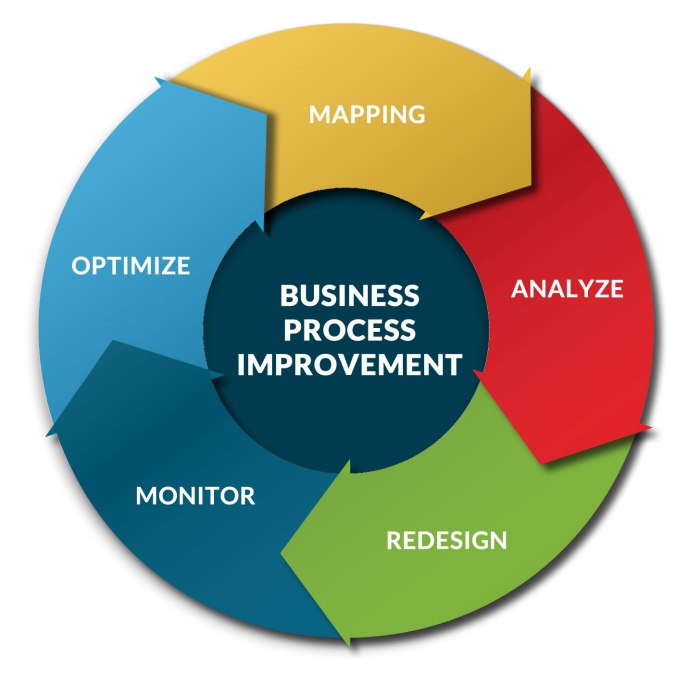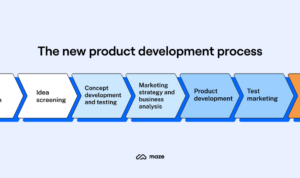Business process improvement sets the stage for boosting efficiency and performance in organizations, paving the way for success in a dynamic business landscape. Get ready for a journey filled with strategies, insights, and real-world examples that showcase the power of optimizing processes.
Overview of Business Process Improvement

Business process improvement is all about making things run smoother, faster, and more efficiently in a company. It involves analyzing current processes, identifying areas for improvement, and implementing changes to optimize operations.
Optimizing business processes is crucial for staying competitive in today’s fast-paced business environment. By streamlining workflows and eliminating bottlenecks, organizations can reduce costs, increase productivity, and deliver better results to customers.
Examples of Successful Business Process Improvement Initiatives
- One successful business process improvement initiative was implemented by a manufacturing company that identified inefficiencies in their production line. By reorganizing the workflow and implementing new technology, they were able to cut production time by 30% and reduce waste significantly.
- Another example comes from a retail company that revamped their inventory management system. By introducing automated tracking and forecasting tools, they were able to reduce stockouts, improve order accuracy, and increase overall customer satisfaction.
- A healthcare organization successfully improved their patient appointment scheduling process by implementing an online booking system. This change not only reduced wait times for patients but also improved staff efficiency and resource allocation.
Methods for Identifying Inefficiencies

Identifying inefficiencies in business processes is crucial for improving productivity and reducing costs. By pinpointing bottlenecks and areas of waste, organizations can streamline their operations and enhance overall performance.
Process Analysis
Process analysis involves breaking down a workflow into individual steps to identify inefficiencies. This method allows businesses to visualize the flow of work and uncover any bottlenecks that may be slowing down the process. By analyzing each step, organizations can determine where improvements can be made to enhance efficiency.
- Utilize Flowcharts: Flowcharts are visual representations of a process that can help identify inefficiencies and bottlenecks. By mapping out each step in a workflow, organizations can easily spot areas that need improvement.
- Time Studies: Conducting time studies involves tracking the time it takes to complete each step in a process. This data can help identify tasks that are taking longer than necessary and are contributing to inefficiencies.
- Value Stream Mapping: Value stream mapping is a method for visualizing the flow of materials and information through a process. By creating a detailed map of the current state of a process, organizations can identify areas of waste and inefficiency.
Strategies for Streamlining Processes: Business Process Improvement
In order to improve efficiency and productivity, businesses often need to streamline their processes. This involves identifying bottlenecks and unnecessary steps in workflows to optimize operations. One effective approach to achieve this is by implementing lean management principles, which focus on continuous improvement and waste reduction.
Lean Management and its Application in Process Improvement
Lean management is a methodology that aims to maximize value for customers while minimizing waste. This approach involves identifying value-added activities and eliminating non-value-added ones to improve overall efficiency. By implementing lean principles, organizations can streamline their processes and enhance performance.
- One key concept of lean management is the elimination of waste, which includes activities that do not add value to the end product or service. By reducing waste, businesses can operate more efficiently and deliver higher quality outcomes.
- Another important aspect of lean management is continuous improvement. This involves regularly reviewing and optimizing processes to ensure that they are as efficient as possible. By fostering a culture of continuous improvement, organizations can adapt to changing market conditions and stay competitive.
- Implementing lean tools such as Kanban boards, value stream mapping, and 5S methodology can help businesses identify inefficiencies and streamline their processes. These tools provide visual representations of workflows and highlight areas for improvement.
Real-World Examples of Organizations that have Successfully Streamlined Processes
Toyota
is a famous example of a company that has effectively implemented lean management principles to streamline its manufacturing processes. By focusing on waste reduction and continuous improvement, Toyota has been able to achieve high levels of efficiency and quality in its production operations.
Amazon
is another organization that has successfully streamlined its processes through the use of technology and data-driven decision-making. By optimizing its supply chain and logistics operations, Amazon has been able to deliver products to customers faster and more efficiently.
Overall, by adopting lean management principles and leveraging technology, organizations can streamline their processes and achieve greater efficiency and productivity.
Implementing Changes and Monitoring Progress
To successfully implement changes and monitor progress in business process improvement, it is crucial to follow a structured approach. This involves identifying key areas for improvement, implementing changes, setting up key performance indicators (KPIs), and continuously monitoring and adjusting processes for sustained improvement.
Steps for Implementing Changes
When implementing changes to improve business processes, it is essential to follow these steps:
- Identify areas for improvement based on the analysis of inefficiencies.
- Develop a detailed plan outlining specific changes to be made and the expected outcomes.
- Communicate changes to all stakeholders and ensure their buy-in and support.
- Implement changes gradually to minimize disruptions to operations.
- Evaluate the effectiveness of changes through performance metrics and feedback.
Setting Key Performance Indicators (KPIs)
Key performance indicators (KPIs) are essential for monitoring progress in business process improvement. Here’s how to set effective KPIs:
- Identify relevant metrics that align with the goals of process improvement.
- Ensure KPIs are specific, measurable, achievable, relevant, and time-bound (SMART).
- Regularly track and analyze KPI data to measure the impact of changes on processes.
- Use KPIs to identify areas that need further improvement and to celebrate successes.
Continuous Monitoring and Adjustment
Continuous monitoring and adjustment are key to sustaining improvements in business processes. Here’s why it’s important:
- Regularly review performance data and adjust processes to address any emerging issues.
- Engage employees in the monitoring process to gather valuable insights and feedback.
- Stay agile and adaptable to changes in the business environment to maintain process efficiency.
- Celebrate achievements and milestones to motivate teams and reinforce a culture of continuous improvement.
Technology’s Role in Business Process Improvement
In today’s fast-paced business environment, technology plays a crucial role in driving efficiency and streamlining processes. By leveraging automation, artificial intelligence (AI), and other digital tools, organizations can optimize their operations and enhance overall performance.
Automation for Process Optimization, Business process improvement
Automation has revolutionized the way businesses operate by reducing manual tasks and increasing productivity. Through the use of robotic process automation (RPA) software, companies can automate repetitive and time-consuming processes, allowing employees to focus on more strategic tasks. This not only saves time but also minimizes errors and increases accuracy in operations.
AI for Enhanced Decision-Making
Artificial intelligence enables businesses to make data-driven decisions by analyzing vast amounts of information quickly and accurately. Machine learning algorithms can identify patterns and trends in data, leading to more informed decision-making processes. For example, AI-powered chatbots can streamline customer service operations by providing instant responses to inquiries, improving customer satisfaction levels.
Digital Tools for Process Enhancement
Various digital tools, such as project management software, workflow automation platforms, and cloud-based collaboration tools, help organizations streamline their processes and enhance communication among team members. These tools facilitate real-time collaboration, task tracking, and document sharing, leading to increased efficiency and productivity.
Examples of Technology-driven Process Improvement
Companies like Amazon, with its advanced logistics and fulfillment automation systems, have successfully leveraged technology to optimize their supply chain processes and deliver products to customers faster. Similarly, Tesla utilizes AI and machine learning algorithms in its production line to improve manufacturing efficiency and quality control.





